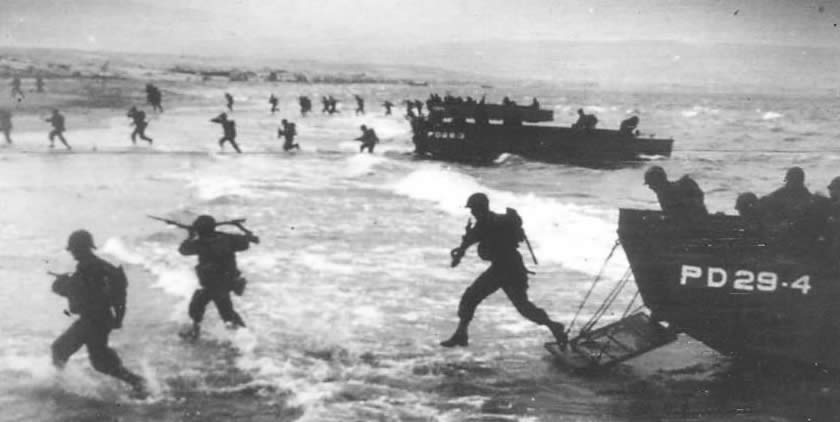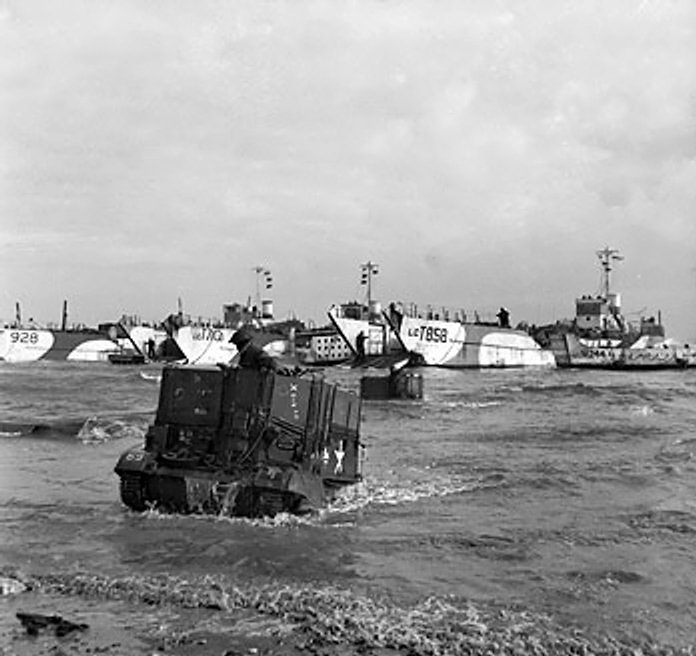Xenophon
Gone and forgotten
In four parts, the allied landings in Normandy France, June 6th 1944
D-Day: Utah Beach
Americans on the right flank
The D-Day landings on Utah were made on the wrong beaches. Had they been made on the correct positions the Americans would have been cut to pieces by an alert German defence but the landings took place some two kilometres south of where they were intended and thereby missed the main part of the German defences in the area. In the event the two leading regiments lost twelve men killed.
Though the assault went off with relative ease the Americans faced considerable problems, most of which stemmed from the vindictiveness of the elements during the build-up of forces after the assault. The weather persuaded the American naval commander to halt unloading during the night of 6th/7th June, but this was overruled by the commanding General and the risks of weather and uncleared obstacles were accepted. In fact by the evening of 6th June the whole of the US 4th Division was ashore and Utah, isolated at the base of the Contentin peninsula, was in reality the most secure of the beaches. German resistance in the immediate vicinity of the beaches was desultory and easily suppressed, though the link-up with the scattered airborne forces was not entirely successful. But Ste Mere Eglise was secured and the Americans were well placed to begin the reduction of German forces in the peninsula.
Utah had been selected outside the main landing areas precisely for the purposes of ensuring two areas of attack, the beach being intended to secure the Contentin peninsula from which further operations could be conducted in the event of failure between the Orne and the Vire. Therefore operations in the peninsula on and after D-Day do not fully belong to the linking of the beachheads since Utah's objectives lay to the west and north rather than the south and east. Within two weeks of landing the Americans were astride the peninsula facing both north and south, the 7th Corps taking Cherbourg on 29th June. Though the main battles in the aftermath of D-Day were to come elsewhere, Utah was crucial in the provision of space and security for the invasion, not least in forcing the Germans to extend their reserves over an ever-widening front.
D-Day: Utah Beach
Americans on the right flank
The D-Day landings on Utah were made on the wrong beaches. Had they been made on the correct positions the Americans would have been cut to pieces by an alert German defence but the landings took place some two kilometres south of where they were intended and thereby missed the main part of the German defences in the area. In the event the two leading regiments lost twelve men killed.
Though the assault went off with relative ease the Americans faced considerable problems, most of which stemmed from the vindictiveness of the elements during the build-up of forces after the assault. The weather persuaded the American naval commander to halt unloading during the night of 6th/7th June, but this was overruled by the commanding General and the risks of weather and uncleared obstacles were accepted. In fact by the evening of 6th June the whole of the US 4th Division was ashore and Utah, isolated at the base of the Contentin peninsula, was in reality the most secure of the beaches. German resistance in the immediate vicinity of the beaches was desultory and easily suppressed, though the link-up with the scattered airborne forces was not entirely successful. But Ste Mere Eglise was secured and the Americans were well placed to begin the reduction of German forces in the peninsula.
Utah had been selected outside the main landing areas precisely for the purposes of ensuring two areas of attack, the beach being intended to secure the Contentin peninsula from which further operations could be conducted in the event of failure between the Orne and the Vire. Therefore operations in the peninsula on and after D-Day do not fully belong to the linking of the beachheads since Utah's objectives lay to the west and north rather than the south and east. Within two weeks of landing the Americans were astride the peninsula facing both north and south, the 7th Corps taking Cherbourg on 29th June. Though the main battles in the aftermath of D-Day were to come elsewhere, Utah was crucial in the provision of space and security for the invasion, not least in forcing the Germans to extend their reserves over an ever-widening front.









